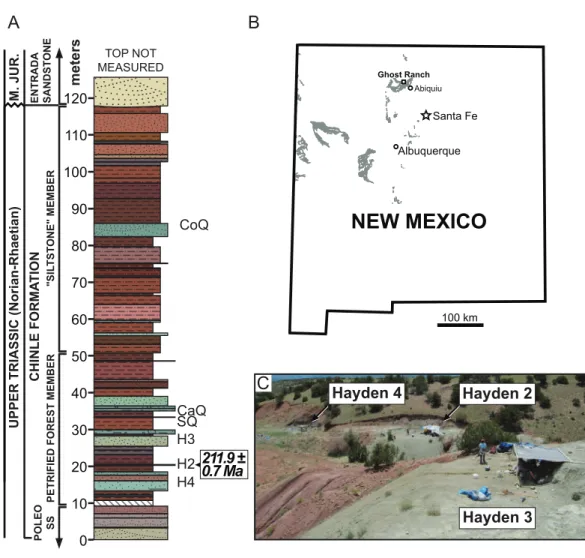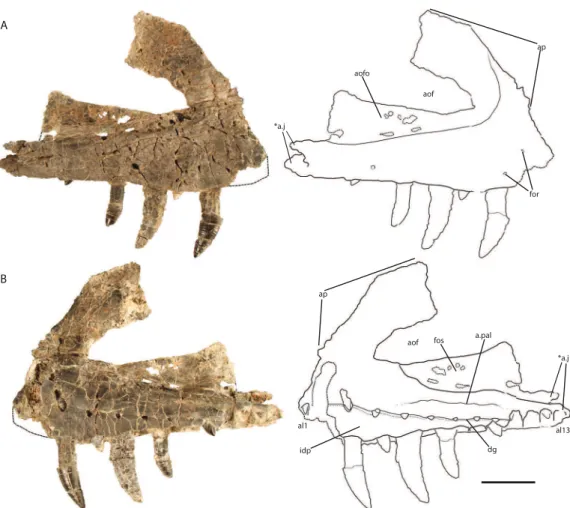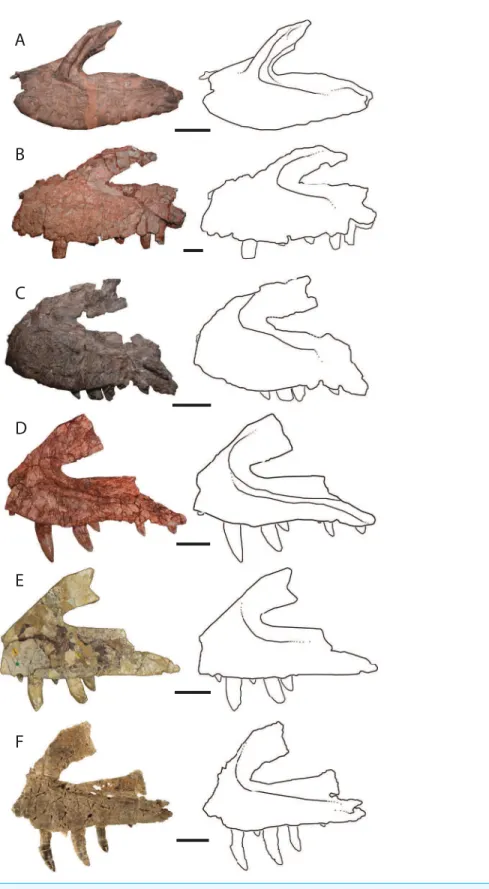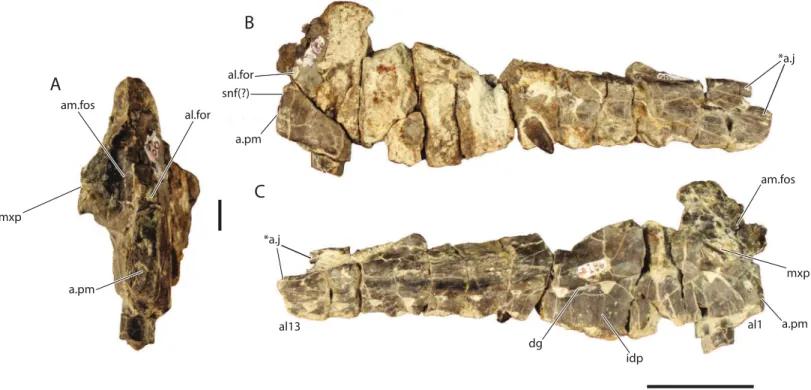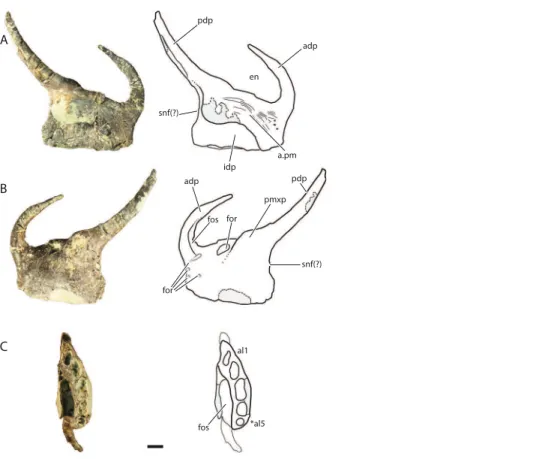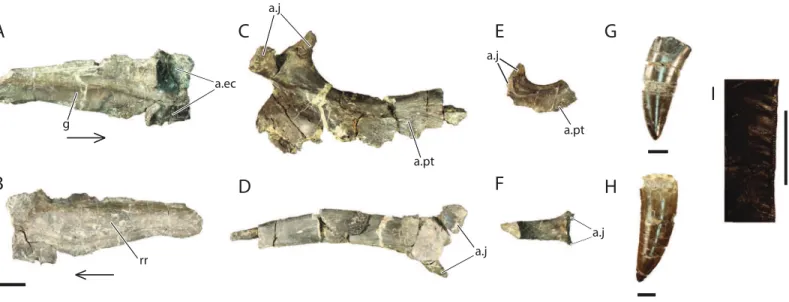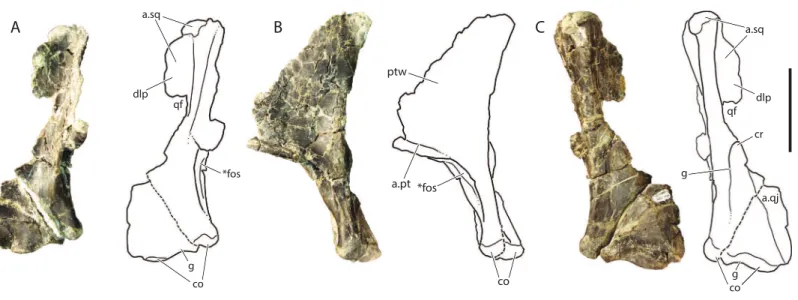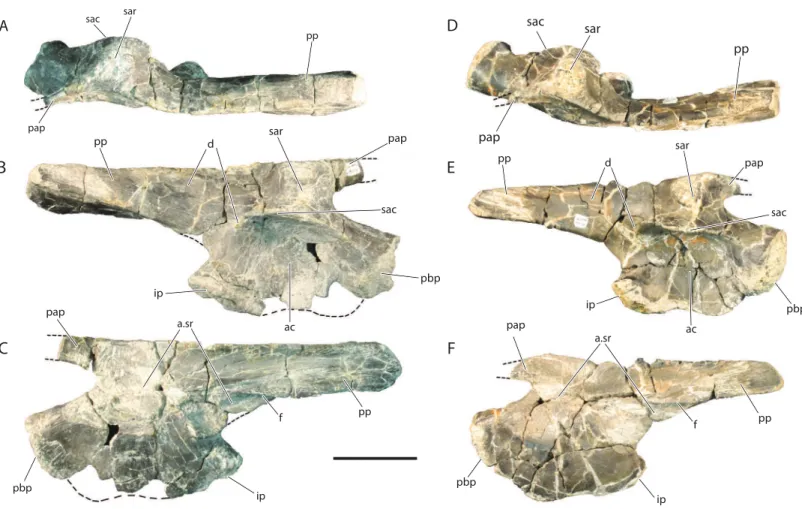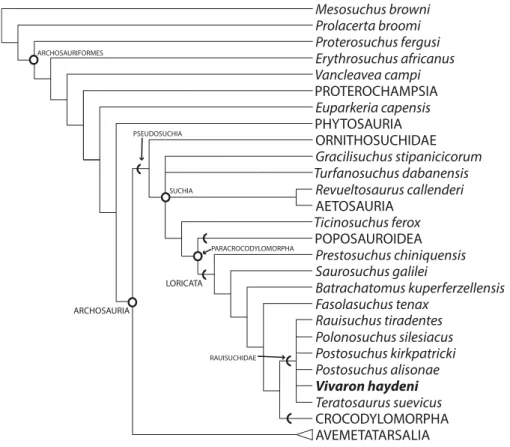A new rauisuchid (Archosauria,
Pseudosuchia) from the Upper
Triassic (Norian) of New Mexico
increases the diversity and temporal
range of the clade
Emily J. Lessner1,2, Michelle R. Stocker1, Nathan D. Smith3, Alan H. Turner4, Randall B. Irmis5,6and Sterling J. Nesbitt1
1Department of Geosciences, Virginia Polytechnic Institute and State University (Virginia Tech),
Blacksburg, VA, United States
2Department of Biological Sciences, Virginia Polytechnic Institute and State University (Virginia
Tech), Blacksburg, VA, United States
3The Dinosaur Institute, Natural History Museum of Los Angeles County, Los Angeles, CA,
United States
4Department of Anatomical Sciences, Stony Brook University, Stony Brook, NY,
United States
5Natural History Museum of Utah, University of Utah, Salt Lake City, UT, United States 6Department of Geology and Geophysics, University of Utah, Salt Lake City, UT, United States
ABSTRACT
Rauisuchids are large (2–6 m in length), carnivorous, and quadrupedal pseudosuchian archosaurs closely related to crocodylomorphs. Though
geographically widespread, fossils of this clade are relatively rare in Late Triassic assemblages. The middle Norian (∼212 Ma) Hayden Quarry of northern New Mexico, USA, in the Petrified Forest Member of the Chinle Formation, has yielded isolated postcranial elements and associated skull elements of a new species of rauisuchid.Vivaron haydenigen. et. sp. nov. is diagnosed by the presence of two posteriorly directed prongs at the posterior end of the maxilla for articulation with the jugal. The holotype maxilla and referred elements are similar to those of the rauisuchidPostosuchus kirkpatrickifrom the southwestern United States, but V. haydenishares several maxillary apomorphies (e.g., a distinct dropoff to the antorbital fossa that is not a ridge, a straight ventral margin, and a well defined dental groove) with the rauisuchid Teratosaurus suevicusfrom the Norian of Germany. Despite their geographic separation, this morphological evidence implies a close phylogenetic relationship betweenV. haydeni andT. suevicus. The morphology preserved in the new Hayden Quarry rauisuchidV. haydenisupports previously proposed and new synapomorphies for nodes within Rauisuchidae. The discovery ofVivaron haydenireveals an increased range of morphological disparity for rauisuchids from the low-paleolatitude Chinle Formation and a clear
biogeographic connection with high paleolatitude Pangea.
Subjects Evolutionary Studies, Paleontology
Keywords Teratosaurus,Postosuchus, Rauisuchidae, Hayden Quarry
Submitted15 April 2016
Accepted17 July 2016
Published6 September 2016
Corresponding author
Emily J. Lessner, ejl2012@vt.edu
Academic editor
Scott Edwards
Additional Information and Declarations can be found on page 24
DOI10.7717/peerj.2336
Copyright
2016 Lessner et al.
Distributed under
INTRODUCTION
There is much confusion in the phylogeny and taxonomy of the Triassic ‘rauisuchians.’ That group typically references large-bodied, mostly carnivorous pseudosuchian archosaurs that clearly are not aetosaurs, phytosaurs, ornithosuchids, or
crocodylomorphs (Gower, 2000;Nesbitt et al., 2013), but establishing the relationships of this assortment of large, quadrupedal, Triassic predators has been challenging. Groups traditionally referred to Rauisuchidae and Rauisuchia are paraphyletic (Nesbitt, 2011, but see Brusatte et al., 2010), but comprise a number of potentially monophyletic subgroups including Prestosuchidae, Poposauroidea, and a much more restricted Rauisuchidae (Brusatte et al., 2010;Nesbitt, 2011). Currently, there is consensus regarding ingroup relationships within some of the smaller clades, but the relationships between the subgroups and to other pseudosuchians remain contentious (Brusatte et al., 2010;Nesbitt, 2011;Lautenschlager & Rauhut, 2015).
Despite the overall disagreement between their respective phylogenetic hypotheses, the analyses ofBrusatte et al. (2010)andNesbitt (2011)recovered a similar taxonomic makeup of Rauisuchidae, which includesPolonosuchus silesiacus,Postosuchus kirkpatricki, and Rauisuchus tiradentes. Teratosaurus suevicus, Tikisuchus romeri, andPostosuchus alisonae were hypothesized to be additional possible members of this group (Brusatte et al., 2010; Lautenschlager & Desojo, 2011;Nesbitt et al., 2013).
Excavations from 2004 to 2015 at the Hayden Quarry at Ghost Ranch, New Mexico, USA have recovered a number of new rauisuchid skeletal elements. Previously, all Late Triassic rauisuchid fossils from Texas, Arizona, and New Mexico were referred to Postosuchus kirkpatricki, including those from the nearby Canjilon Quarry at Ghost Ranch (Long & Murry, 1995). The discovery of a rauisuchid clearly distinguishable from Postosuchusprovides reason to reevaluate all previously referred rauisuchid material from the southwestern United States. Here, we describe these skeletal elements from the Hayden Quarry and erect a new taxonVivaron haydenigen. et. sp. nov. Our comparisons are either through first-hand examination of specimens and/or digital reconstructions of computed tomographic (CT) data from relevant rauisuchid specimens. Our analyses reveal that rauisuchids occupied a large biogeographic range with a wide latitudinal distribution over Pangea during the Carnian and Norian (Benton, 1986;Nesbitt et al., 2013).
MATERIALS AND METHODS
The rock matrix of the Hayden Quarry ranges from mudstone/siltstone to
and a pixel spacing of 0.969 mm. The resolution of the CT scan data was high enough to record much of the internal structure of the maxilla.
The electronic version of this article in Portable Document Format (PDF) will represent a published work according to the International Commission on Zoological Nomenclature (ICZN), and hence the new names contained in the electronic version are effectively published under that Code from the electronic edition alone. This published work and the nomenclatural acts it contains have been registered in ZooBank, the online registration system for the ICZN. The ZooBank Life Science Identifiers (LSIDs) can be resolved and the associated information viewed through any standard web browser by appending the LSID to the prefixhttp://zoobank.org/. The LSID for this publication is: urn:lsid:zoobank.org:pub:7022E830-4C36-470A-BF78-10BE500E1519. The online version of this work is archived and available from the following digital repositories: PeerJ, PubMed Central and CLOCKSS.
SYSTEMATIC PALEONTOLOGY
ARCHOSAURIACope, 1870sensuGauthier & Padian, 1985 SUCHIA Krebs, 1974sensuSereno, 1991
RAUISUCHIDAEvon Huene, 1942sensuNesbitt, 2011 Vivaron haydenigen. et sp. nov.
Derivation of name:Vivaron, named for the mythical 30-foot rattlesnake demon believed to haunt Orphan Mesa at Ghost Ranch (Poling-Kempes, 2005);haydeni, in honor of John Hayden, who discovered the Hayden Quarry from which the type and referred material was collected.
Holotype:right maxilla (GR 263).
Referred material:left premaxilla (GR 391), left maxilla (GR 186), left jugal (GR 641), right quadrate (GR 639), right ectopterygoid (GR 640), right ectopterygoid (GR 451). We tentatively refer to this taxon a right ilium (GR 638), right ilium (GR 642), tooth (GR 560), tooth (GR 664).
Type Horizon: Petrified Forest Member, Chinle Formation (Late Triassic: middle Norian,∼212 Ma) (Irmis et al., 2011).
Type Locality:Hayden Quarry 2 paleochannel, Ghost Ranch, Rio Arriba County, New Mexico, USA. Referred material is from Hayden Quarry paleochannels 2, 3, and 4; all three paleochannels are geographically within 30 m of each other and stratigraphically within 15 m of each other (Fig. 1).
(ZPAL AbIII/563), a ventral margin that is straight rather than sinuous as inPos. kirkpatricki(TTU-P 9000) andPol. silesiacus(ZPAL AbIII/563), and a well-defined dental groove. In comparison withPol. silesiacus(ZPAL AbIII/563), the maxilla ofV. haydenihas a straighter anterior border, an antorbital fossa that extends further ventrally onto the ascending process, completely fused interdental plates, and a palatal process that does not extend as far medially.Rauisuchus tiradentes (BSPG AS XXV 60) does not preserve a maxilla but preserves four premaxillary alveoli, as do the premaxillae ofSaurosuchus galilei,Fasolasuchus tenax,Pol. silesiacus, andPos. kirkpatricki, whereas the referred premaxilla ofV. haydeni(GR 391 contains five alveoli, the same state as in many early crocodylomorphs (Nesbitt, 2011).
Remarks:Our description is based on 11 skeletal elements discovered in the Hayden Quarry; this site comprises three separate but closely associated paleochannels at
A TOP NOT MEASURED ENTRADA SANDST O NE "SIL TST ONE" MEMBER
PETRIFIED FOREST MEMBER
POLEO SS meters H4 CaQ SQ CoQ H2 H3 211.9 ± 0.7 Ma CHINLE FORMA TION
UPPER TRIASSIC (Norian-Rhaetian)
M. JUR. 120
110 100 90 80 70 60 50 40 30 20 10 0 C Hayden 3 Hayden 2 Hayden 4 Santa Fe Albuquerque
NEW MEXICO
Abiquiu 100 km B Ghost RanchGhost Ranch in northern New Mexico, USA (Fig. 1) (seeIrmis et al., 2007;Irmis et al., 2011;Nesbitt et al., 2009a;Nesbitt et al., 2009b;Whiteside et al., 2015;Pritchard et al., 2015for more information about this locality and its geology). Material from Hayden paleochannel 2 includes: the holotype maxilla (GR 263), GR 186, GR 391, GR 639, and GR 640. GR 263 is very thin, having been flattened mediolaterally during preservation but is the same length anteroposteriorly as the referred left maxilla (GR 186). The right quadrate (GR 640) is complete but has been crosscut by a small, mineralized fault plane, resulting in its collection as two separate pieces that do not fit back together precisely. All of the skull elements found in Hayden paleochannel 2 are about the same size, lack overlapping elements, and were found within a few meters of each other. Therefore, we hypothesize that they belong to the same individual, yet we only designate the nearly complete right maxilla as holotype. Two right ilia (GR 638 and GR 642) were found in Hayden paleochannel 3 and are assignable to Rauisuchidae using apomorphies, so we tentatively refer them toVivaron. Hayden paleochannel 4 yielded additional disarticulated cranial material assignable to Rauisuchidae, so these specimens are is also tentatively assigned to the new taxon (GR 451, GR 560, GR 641, and GR 664).
COMPARATIVE MORPHOLOGICAL DESCRIPTION
Maxilla (holotype, GR 263)
The right maxilla (Fig. 2) is dorsoventrally tall and mediolaterally compressed with a sub-rectangular main body in lateral view. Although nearly complete, the anteriormost portion is not preserved, and therefore details of its articulation with the premaxilla and the presence of a subnarial fenestra are not clear. The dorsal and ventral
margins are sub-parallel across the length of the maxilla from the posterior end to the base of the ascending (= dorsal) process at the anterior end. The ventral margin is nearly straight dorsal to alveoli seven through 13 and gently convex above alveoli three through six.
The ascending process forms the rounded dorsal edge of the antorbital fenestra, and the dorsal border of the main body of the maxilla forms the straight ventral edge of the fenestra. The anterior half of the antorbital fenestra is wedge-shaped, widening posteriorly and tapering in dorsoventral depth anteriorly similar to the condition in S. galilei, B. kupferzellensis,F. tenax,T. suevicus,Pos. kirkpatricki, andPol. silesiacus(Nesbitt, 2011). Much of the lateral surface of the ascending process forms part of the antorbital fossa, which then extends posteriorly from the base of the ascending process to where the maxilla terminates at its contact with the lacrimal and jugal. The antorbital fossa widens dorsoventrally towards the jugal process of the maxilla as this process itself narrows dorsoventrally; as a result, the fossa occupies a larger proportion of the maxilla as it extends posteriorly along the element. The shape of the antorbital fossa is similar to that of T. suevicus(NHMUK 38646) andPos. kirkpatricki(TTU-P 9000) in that the fossa extends dorsally onto the ascending process anteriorly, and also extends posteriorly along the entire length of maxilla (Fig. 3). This differs from the antorbital fossa ofPol. silesiacus (ZPAL AbIII/563), which does not extend as far dorsally onto the ascending process or as
A
B
aof
ap
aofo
*a.j a.pal
idp dg
fos
for
aof *a.j
ap
al1 al13
A
D
F E C B
Figure 3 Left lateral views and interpretive drawings of the maxillae of (A) Batrachotomus kupferzellensis (SMNS 52970), (B) Fasolasuchus tenax (PVL 3851), (C) Polonosuchus silesiacus
(ZPAL AbIII/563), (D) Postosuchus kirkpatricki (TTU-P 9000), (E) Teratosaurus suevicus
far posteriorly along the jugal process of the maxilla, and also has a sinuous ventral margin (Fig. 3). The antorbital fossa of other closely related loricatans (e.g.,Saurosuchus galilei (PVSJ 32), Batrachotomus kupferzellensis(SMNS 52970), andFasolasuchus tenax(PVL 3851)) extends dorsally onto the posterior portion of the ascending process only rather than onto the entire ascending process as in rauisuchids (Fig. 3).
The posterior portion of the maxilla is laterally expanded with two prongs that comprise the articulation with the jugal (Fig. 2). The ventromedially-positioned prong also houses the posteriormost four alveoli, and is both mediolaterally thicker and dorsoventrally taller than the lateral prong. The dorsolateral prong is a thin, wing-like projection that originates posteroventral to the antorbital fenestra and extends
posteromedially. The two prongs are slightly separated, creating a slot for articulation with the jugal. This morphology is autapomorphic forVivaron haydeni, whereas other rauisuchids (Pos. kirkpatricki(TTU-P 9000), Pol. silesiacus (ZPAL AbIII/563), and T. suevicus(NHMUK 38646)) have only a single prong (Fig. 3), which is homologous to the ventromedial prong inV. haydeni.
The palatal process on the anterior portion of the medial surface of the maxilla of V. haydeni is not preserved, and the bone and interdental plates covering the first and second alveoli are missing as well. However, it is clear that the maxilla does widen medially over the second alveolus, indicating that the palatal process was present. The medial surface of the maxilla possesses a depression just ventral to the antorbital fenestra; this structure mirrors the shape of the antorbital fossa on the lateral side. This medial fossa extends posteriorly from dorsal to the fifth alveolus and is bordered ventrally by the rounded, raised portion of the maxilla until the tenth alveolus (Fig. 2B). Poor preservation of the thin portion of bone that forms the fossa makes it difficult to interpret whether an “infraorbital foramen” (sensuGalton, 1985) is present on the surface of the bone forming the fossa, as inT. suevicus, B. kupferzellensis,Pos. kirkpatricki,Arganasuchus(ALM 1), and Arizonasaurus(Brusatte et al., 2009). The medial fossa terminates posteriorly where the maxilla contacts the lacrimal and jugal. The posterior margin of the fossa is poorly preserved and its exact morphology is not clear. Just ventral to the fossa, an articular surface is preserved as a ridge and groove that parallels the ventral edge of the medial fossa as in T. suevicus(NHMUK 38646). The position and shape of this scar inV. haydeni corresponds to the articulation for the palatine inPos. kirkpatricki (Weinbaum, 2011).
plates are fused inV. haydeni,Pos. kirkpatricki,T. suevicus, andF. tenax, though only the posterior half of the interdental plates are fused in Pol. silesiacus(Nesbitt, 2011). There are minute nutrient foramina on the medial surfaces of the interdental plates, and the interdental plates are nearly square and decrease in dorsoventral height posteriorly from alveolus three onwards. Poor preservation has destroyed the plates dorsal to alveolus one, two, and ten to thirteen.
There are 13 alveoli and 12 teeth preserved in the right maxilla. A count of 13 alveoli is similar to Pos. kirkpatricki(TTU-P 9000) andT. suevicus(NHMUK 38646) but not Pol. silesiacus(ZPAL AbIII/563), which has 11 preserved alveoli. The first and second alveoli ofV. haydeniare damaged, with the medial wall missing from the ventral margin to the base of the ascending process. The first alveolus is smaller than the second, and the alveoli decrease in size posteriorly from the second alveolus. Five erupted teeth are visible in lateral view (Fig. 2A). The two largest teeth are in the third and fifth alveoli.
Another large tooth was shifted post-mortem from either the sixth or the seventh alveolus and sits in between those two alveoli. Two smaller, erupted teeth are present in the fourth and ninth alveoli. The lack of preservation of interdental plates has revealed replacement teeth in the first, 10th, and 12th alveoli, whereas CT data reveal the presence of four more replacement teeth, dorsal to alveolus three, four, five, and seven (Fig. 4). The replacement teeth are developing medially and parallel to the erupted teeth. The
morphology of the individual teeth is described below.
Maxilla (GR 186)
The ascending process of the left maxilla (Fig. 5) has broken away, but the preserved portion is nearly identical to GR 263, and could belong to the same individual. The holotype and GR 186 share the presence of 13 maxillary alveoli, a well-defined dental groove, fused interdental plates, the lack of a laterally expanded lateral ridge, and the autapomorphy of two posteriorly directed prongs at the posterior end, indicating that they are referable to the same species.
Unlike the holotype, the anterior margin and palatal process of GR 186 are preserved. Ventral to the ascending process, the anterior margin of the maxilla is nearly vertical at its ventral termination, similar toT. suevicus(NHMUK 38646); this condition contrasts with the more posterodorsally angled anterior margin of the maxilla inPos. kirkpatricki (TTU-P 9000) and the convexly rounded anterior margin inPol. silesiacus (ZPAL AbIII/563). On the medial surface, the palatal process is broken at its anterior edge, but the preserved portion extends anteroventrally from its origination dorsal to the third alveolus. The medial surface of the process displays a groove that extends anteroventrally from the posterior portion of the palatal process towards the anterior portion of the main body of the maxilla. The placement and orientation of the palatal process are similar to those ofT. suevicus(NHMUK 38646) andPos. kirkpatricki(TTU-P 9000). In both GR 186 andT. suevicus(NHMUK 38646), ventral to the palatal process, the dental groove deflects anteroventrally between the first and second alveoli (Brusatte et al., 2009).
The palatal process overhangs the medial surface of the maxilla, forming an
foramen’ in T. suevicusbyBrusatte et al. (2009), is also present inPos. kirkpatricki (TTU-P 9000) andPol. silesiacus (ZPAL AbIII/563) as well as the large non-rauisuchid paracrocodylomorphsFasolasuchus(PVL 3851) and Batrachotomus(Gower, 1999). The anteromedial foramen does not extend posteriorly into the maxilla in GR 186 and is a fossa rather than the foramen described byBrusatte et al. (2009). The anterior surface of the maxilla also preserves an anterolateral foramen (Figs. 5Aand5B), (described as the ‘rostrolateral foramen’ inT. suevicusbyBrusatte et al., 2009), which is also present in Pos. kirkpatricki(TTU-P 9000) andPol. silesiacus(ZPAL AbIII/563) as well. These foramina may be present inBatrachotomus, and it is difficult to determine their presence in Saurosuchus,Fasolasuchus, and other loricatans because the feature is not described or figured in the literature.
GR 186 possesses 13 alveoli. The anteriormost alveolus is notably smaller than the following alveoli, a character state shared withT. suevicus(NHMUK 38646) and Pos. kirkpatricki, though not withPol. silesiacus(Weinbaum, 2011).V. haydenidiffers from
A
B
T. suevicus(NHMUK 38646) in that the second alveolus in GR 186 contains a much larger tooth.
Premaxilla (GR 391)
The left premaxilla (Fig. 6) comprises a sub-rectangular main body with complete anterodorsal (= nasal) and posterodorsal (= maxillary) processes. The premaxilla is slightly longer anteroposteriorly than it is tall dorsoventrally and narrows anteriorly in the dorsoventral direction across its entire length, more so than the premaxilla of Pos. kirkpatricki(TTU-P 9000) andPol. silesiacus(ZPAL AbIII/563). There are four small nutrient foramina on the anterolateral surface of the premaxilla. Two of those foramina are ventral to the anterodorsal process, whereas the other two are slightly posterior to these.
The anterodorsal process of the premaxilla is shorter than the anteroposterior length of the premaxilla, a character state described by Nesbitt (2011)as present in nearly all archosauriforms, but it is broken at the tip like the anterodorsal processes in Pos. kirkpatricki(TTU-P 9000) andPol. silesiacus(ZPAL AbIII/563). The anterodorsal process in GR 391 rises from the premaxilla body and curves posteromedially to where it would contact the nasal as in the condition described forPos. kirkpatricki(TTU-P 9000) (Weinbaum, 2011). The anterodorsal process forms the anterior border and anterodorsal corner of the external naris.
A
B
C
al.for am.fos
mxp
mxp al.for
a.pm
a.pm *a.j
dg
idp snf(?)
a.pm
*a.j
am.fos
al1 al13
Figure 5 Referred left maxilla ofVivaron haydenigen. et. sp. nov. (GR 186) in (A) anterior, scale bar = 1 cm (B) lateral, and (C) medial views.
There are two prominences on the dorsolateral surface of the premaxilla (Fig. 6B) that represent a shared character state withPos. kirkpatricki(Weinbaum, 2011) and R. tiradentes(BSPG AS XXV 60; previously described as autapomorphic for this taxon by Lautenschlager & Rauhut (2015)). InR. tiradentesthese begin as knob-like thickenings at the base of the posterior process of the premaxilla and are notably more rugose than the premaxillary body (Lautenschlager & Rauhut, 2015). In contrast, the prominences on GR 391 are less well-defined than inPos. kirkpatricki(TTU-P 9000) andR. tiradentes (BSPG AS XXV 60) and have no groove dividing them. The first prominence in GR 391 extends from the middle of the dorsal margin of the premaxilla to the base of the posterodorsal process. It is marked by the presence of a large foramen (Fig. 6B) (identified as a resorption pit byWeinbaum, 2011) that has been widened by preservational damage. The foramen in GR 391 opens medially, extending deep into the body of the premaxilla. The posterodorsal process projects posterodorsally from the second prominence, likely separates the maxilla and external naris, and forms the posterior and posteroventral borders of the ovate and anteroventrally angled external naris. This external naris shape and angle were described as subterminal byWeinbaum (2011), and are character states shared withPos. kirkpatricki(TTU-P 9000) andR. tiradentes(BSPG AS XXV 60); it is
B
C
A adp
pdp
pmxp en
for
snf(?) a.pm
*al5
adp pdp
snf(?)
fos
for
al1
fos idp
difficult to determine if this is also shared with Pol. silesiacusbecause of incomplete preservation. The posterior surface of the posterodorsal process of GR 391 is concave. Ventral to the posterodorsal process, the posterior surface of the premaxilla is indented, indicating the possibility of a small subnarial foramen, a character state present in Pol. silesiacus, Pos. kirkpatricki,andR. tiradentes(Nesbitt, 2011). The anteroventral margin of the external naris of GR 391 is bordered by a shallow fossa that spans from the anterodorsal process to the base of the posterodorsal process (Fig. 6B). This depression is also present inPol. silesiacus(ZPAL AbIII/563),B. kupferzellensis(SMNS 80260), and Pos. kirkpatricki(TTU-P 9000).
The medial surface of the premaxilla preserves the premaxillary symphysis and a deep fossa located posterolateral to the symphysis and ventral to the base of the posterodorsal process (Fig. 6C). This fossa is also present inR. tiradentes(BSPG AS XXV 60) and Pos. kirkpatricki(TTU-P 9000). The premaxillary symphysis forms an anterodorsally-oriented shelf that overhangs the fossa on the medial surface of the premaxilla from the second to the fifth alveolus (Fig. 6A). The symphysis is flat and covered with small foramina and grooves that cover the anterior and ventral portions of the premaxilla from the base of the posterodorsal process to the anterodorsal process. The premaxillary interdental plates are fused.
There are five alveoli preserved in the premaxilla. The presence of five premaxillary alveoli inV. haydenidiffers from the four alveoli present in all other rauisuchids (Pos. kirkpatricki,Pol. silesiacus,R. tiradentes) and their close relatives (Batrachotomus, Fasolasuchus, andSaurosuchus). A skull reconstruction ofPos. kirkpatricki(UCMP A269) figured inLong & Murry (1995: Fig. 121)shows a left premaxilla possibly preserving a fifth alveolus. In contrast, five or more premaxillary alveoli are present in early crocodylomorphs (e.g.,Redondavenator quayensis(NMMNH P-25615) and
Hesperosuchus agilis(CM 29894)) (Nesbitt, 2011). The anteriormost alveolus in GR 391 is oval and angled anterolaterally. The alveoli cross-sections become more sub-circular posteriorly. The third alveolus is the largest (13 mm across its longest axis and 6 mm across its shortest axis) and the fifth alveolus is the smallest (diameter of 4 mm).
Jugal (GR 641)
slightly angled in the ventrolateral direction. The medial surface of the jugal also has a groove that extends longitudinally along its length, arcing dorsally and separating the ectopterygoid articulations. This is also present inPos. kirkpatricki(TTU-P 9000) and R. tiradentes (BSPG AS XXV 63).
Quadrate (GR 639)
The right quadrate (Fig. 8) comprises a dorsoventral main shaft that widens ventrally into a triangle of bone in posterior view. This shaft is a ridge that terminates ventrally at the medial condyle of the glenoid. The anterior surface of the shaft has a concave surface that extends ventrally from the dorsal head and laterally onto the ventral body of the quadrate. The dorsalmost surface of the quadrate is rounded into a head that is the articular surface with the squamosal. The general shape of the quadrate, including the condyles and dorsoventrally oriented crest, is very similar to those ofPos. kirkpatricki (TTU-P 9000) andPol. silesiacus (ZPAL AbIII/563).
The dorsal head of the quadrate possesses a posteriorly-oriented hook that is identical to that ofPos. kirkpatricki(TTU-P 9000) and may be present inPol. silesiacus(ZPAL AbIII/563), though it is difficult to determine its presence because the feature is not described in the literature. Both a dorsolateral process and a pterygoid wing extend from the dorsal head in GR 639. The dorsolateral process extends from just ventral to the dorsal head to just dorsal to the quadrate foramen (discussed below). The dorsolateral process would articulate with the descending ramus of the squamosal, similar to the condition inPos. kirkpatricki(TTU-P 9000). On the medial surface of GR 639, a large pterygoid wing projects anteromedially from the dorsal head to just dorsal to the anteromedially-facing fossa (described below). There is a horizontally oriented shelf on
A
B
C
D
E
F
G
H
a.pt a.j
a.j a.ec
rr g
a.j
a.pt a.j
I
the ventral surface of the pterygoid wing, and just dorsal to the shelf is the articular surface for the pterygoid, as seen inPos. kirkpatricki(TTU-P 9000).
The dorsolateral portion of the quadrate has a shallow and wide groove that extends laterally onto the dorsolateral wing. Just ventral to the dorsolateral wing, the medial portion of the quadrate foramen is present. There is a dorsoventrally oriented crest just ventral to the quadrate foramen and just dorsal to the articulation with the quadratojugal; this morphology results in a medially arcing concave surface (Fig. 8C). This crest is also present inPos. kirkpatrickiandPol. silesiacus(Nesbitt, 2011). The concave surface is part of a groove that extends from the quadrate foramen to the ventral body of the quadrate above the medial condyle. InPos. kirkpatricki(TTU-P 9000), the groove on the posterior surface of the distal end stretches to the medial surface of the quadrate, whereas in GR 639, the groove trends similarly, arcing medially and ventrally, but does not extend to the medial surface of the quadrate. The distal articular surface for the glenoid comprises two condyles separated by a shallow groove that trends anteromedially (Figs. 8Aand8C). The articulation with the quadratojugal is a shelf on the lateral surface of the ventral portion of the quadrate that is separated from the rest of the quadrate by a small, sharp ridge.
The ventromedial surface of the quadrate has a deep fossa (Figs. 8Aand8B) just ventral to the shelf on the pterygoid ramus. The fossa opens anteromedially, is surrounded on both sides by ridges, and shallows ventrally to a groove that trends towards the medial condyle. This characteristic has not been commented upon previously but may be present inPos. kirkpatrickiandB. kupferzellensis, though it is not described or figured in the literature.
Ectopterygoid (GR 640; GR 451)
The following descriptions refer to the right ectopterygoid, GR 640 (Figs. 7Cand7D), because the other right ectopterygoid GR 451 (Figs. 7Eand7F) is less complete and
B C
A
a.qj qf
a.sq
g *fos
*fos
a.pt
cr
co g
co
co a.sq
qf
g
dlp dlp
ptw
pertains to a smaller individual (only 2.5 cm long anteroposteriorly, compared to 9 cm long in GR 640). Besides their relative sizes, the only noticeable difference between the two specimens is that the lateral surface of GR 451 is concave in the center.
The ectopterygoid is ‘J’-shaped with a thickened anterior head and a tapering posterior process that arches dorsally and anteriorly. This is in contrast to the ectopterygoid of Pos. kirkpatricki(TTU-P 9000), which only arcs anteriorly. The head of the ectopterygoid of V. haydenidisplays both dorsal and ventral processes (Figs. 7C–7F) that are likely articular surfaces for the jugal, similar toPos. kirkpatricki,Pol. silesiacus,Batrachotomus, Sphenosuchus, andHespersuchus “agilis”(Nesbitt, 2011). It is difficult to determine if there is a groove separating these two processes in GR 640 because poor preservation has eliminated much of the surface where the groove is expected. The dorsal process possesses a groove on its ventral surface that extends onto the dorsal surface of the ectopterygoid.
The ectopterygoid is concave ventrally and laterally. The anterior portion of the ectopterygoid extends medially as a thin flange that narrows dorsoventrally. Sutural surfaces, thin scars filled with small pitting, trend anteroposteriorly in the posterodorsal region of the ectopterygoid. The posteromedial surface of the ectopterygoid has a raised ridge anterior to the jugal contact. There is a large flange on its medial side that appears to contribute to a large portion of the pterygoid flange, a shared character state of Archosauriformes (Nesbitt, 2011). The posterior process of the ectopterygoid narrows medially. Some small scars are visible on the medial surface of the posterior process where the pterygoid would contact the ectopterygoid.
Dentition
Both the isolated (GR 560, GR 664) (Figs. 7Gand7H) and in situ maxillary teeth (Fig. 2) are recurved at the tip, oval in cross-section, mediolaterally compressed, have lineations trending dorsoventrally, and are serrated on both their anterior and posterior carinae. Serration density averages three serrations per millimeter, similar toPos. kirkpatricki (Weinbaum, 2011); this is less dense than the 4–5 serrations per millimeter reported by Lautenschlager & Rauhut (2015)forR. tiradentes. The isolated teeth are similar in size to the two largest maxillary teeth of GR 263. The largest in situ maxillary tooth from GR 263, and both isolated teeth (GR 560 and GR 664) have wrinkled enamel along the posterior carina (Fig. 7I). This character state is also present inBatrachotomus(SMNS 52970), other rauisuchids, and theropod dinosaurs (Brusatte et al., 2009). The wrinkles extend anteriorly over the posterior half of the tooth and dorsoventrally along the entire carina. Though the isolated teeth are consistent with the maxillary teeth ofV. haydeni, we acknowledge that serrated, mediolaterally compressed, recurved teeth are
plesiomorphic for Archosauria.
Ilium (GR 638; GR 642)
and pubis, as well as dorsal preacetabular and postacetabular processes. The preacetabular process on both GR 638 and GR 642 is broken anteriorly, so it is impossible to determine whether or not it extends anterior to the acetabulum, as inPos. kirkpatrickiand
crocodylomorphs (Nesbitt, 2011). The preserved portion of the preacetabular process curves medially and narrows anteriorly. The preacetabular process is separated from the postacetabular process by a thick, vertical, laterally expanded ridge (Figs. 9A,9B,9D and9E) dorsal to the supra-acetabular crest. This ridge is also present in SMNS 52972 (an ilium previously assigned toTeratosaurus; discussed below) andPos. kirkpatricki (TTU-P 9002), and is present but less expanded inS. galilei,B. kupferzellensis, and members of Poposauroidea (Gower & Schoch, 2009;Nesbitt, 2011). The ilium is 3 cm thick mediolaterally at the supra-acetabular ridge dorsal to the acetabular crest in GR 638 and 2.5 cm mediolaterally in GR 642.
Laterally, the acetabulum is a deep, round depression that measures 5.5 cm high dorsoventrally in GR 638 and 5 cm high in GR 642. The dorsal edge of the acetabulum is formed by a laterally projecting supra-acetabular crest that overhangs the rest of the
A
B
C
E
F sar
sar
ac a.sr
ip
pbp pap pp
sac d
pp
pp
pp pp
pp
d
sar
sar
pap
pap
pap
pap pap
a.sr ac ip
ip ip
pbp
pbp pbp
sac
sac sac
D
f f
acetabulum (it is angled slightly ventrally GR 642 only). This rim defines the mediolateral width of the ilium; it extends anteriorly onto the lateral surface of the pubic peduncle, and has a small depression (Figs. 9Band9D) at its posterior terminus. The ventral border of the ilium is convex along the ventral margin of the pubic peduncle and slightly concave along the same margin of the ischial peduncle. Overall, the ventral margin is mediolaterally thin and sinuous in lateral view in both GR 638 and GR 641, a feature shared with SMNS 52972, whereas the same region converges to a convex point in Pos. kirkpatricki(TTU-P 9002).
The postacetabular process of the ilium ofV. haydenicomprises half the total
anteroposterior length of the ilium, and tapers posteriorly. There are many small grooves trending longitudinally along the lateral surface of the postacetabular process which could be the muscle attachment site for the flexor tibialis externus (Schachner, Manning & Dodson, 2011). There is a small ridge on the postacetabular process dorsal to the ischial peduncle that is the dorsal border of a slight oval depression on the postacetabular process (Figs. 9B and9D). The postacetabular process meets the acetabular region of the ilium at a more dorsal point than in thePos. kirkpatricki(UMMP 7333) and SMNS 52972, with a clear separation of the ischial peduncle and the anteroventral-most part of the postacetabular process. The medial ridge of the postacetabular process has a medioventrally extending blade-like flange trending anteroposteriorly along its surface (Figs. 9Cand9F). In both GR 642 and SMNS 52972, the postacetabular process arcs medially at its base whereas inPos. kirkpatricki(UMMP 7266) the postacetabular process is straighter. In lateral view, the dorsal edge of the postacetabular process ofV. haydeni is flat, similar to SMNS 52972 but differing fromPos. kirkpatricki(UMMP-7333), in which the process expands slightly dorsally at its middle portion. In dorsal view, the dorsal border of the ilium is sinuous, similar to that of SMNS 52972 andPos. kirkpatricki (TTU-P 9002).
The medial surface of the ilium ofV. haydeniis smooth with the exception of the articular surfaces for sacral ribs. GR 638, GR 642, andPos. kirkpatricki(TTU-P 9002) possess two sacral rib articular facets whereas SMNS 52972 appears to have two, but has been reported to have three (Galton, 1985). Of the two observed in V. haydeni, the first facet is medial to the thickened supra-acetabular ridge dorsal to the acetabular crest. The second sacral rib facet is located where the postacetabular process meets the acetabulum and extends onto the postacetabular process, ventral to the flange.
ilium SMNS 52972 toT. suevicus. However, such a referral must remain tentative given that the type material of both taxa (i.e.,T. suevicusandV. haydeni) was not found associated with their respective putative ilia.
PHYLOGENETIC ANALYSIS
Methods
We used a modified version of the data set ofNesbitt (2011), consisting of 412 characters and 80 terminal taxa, to examine the phylogenetic relationships of Vivaronwithin Pseudosuchia.Vivaron haydeniwas scored for 61 characters using the holotype and referred specimens. We also includedTeratosaurus suevicus,which could only be scored for 23 characters (all maxillary).Tikisuchus romeri, though most likely a member of Rauisuchidae, was not included in the analysis because the material is incompletely described in the literature and none of the authors have observed the material first hand. A new state was added to character 26 (maxilla, lateral surface: (0) smooth; (1) sharp longitudinal ridge present; (2) bulbous longitudinal ridge present; (3) distinct dropoff to antorbital fossa (new)); this new character state is only scored as present inV. haydeniand T. suevicus. The scorings for the ilium ofRauisuchus tiradentes were changed to
uncertainty (?) followingLautenschlager & Rauhut’s (2015)observation that the only known ‘Rauisuchus’ ilium (BSPG AS XXV 88) could not be confidently assigned to the species. The distributions of five additional characters within Pseudosuchia are not well-characterized with the current taxon sampling regime so they were not included in the analysis. These include: the presence or absence of lateral protuberances at the base of the posterior (= maxillary) premaxillary process of the premaxilla (as a possible character state in Fasolasuchus tenax, Rauisuchidae, and Crocodylomorpha); the presence or absence of a shallow fossa on the premaxilla bordering the anteroventral margin of the external naris (as a possible character state inV. haydeni,Pos. kirkpatricki,Pol. silesiacus, andB. kupferzellensis); the presence or absence of an anterolateral foramen on the anterior surface of the maxilla (as a possible character state inV. haydeni,T. suevicus, Pos. kirkpatricki, andPol. silesiacus); the presence or absence of an anteromedially opening fossa on the ventromedial surface of the quadrate (as a possible character state in V. haydeni,Pos. kirkpatricki, andB. kupferzellensis); and the presence or absence of a posteriorly-oriented hook on the dorsal head of the quadrate (as a possible character state in V. haydeni,Pos. kirkpatricki, andPol. silesiacus).
Five original terminal taxa were deleted (Prestosuchus chiniquensis, UFRGS 0156-T, UFRGS 152-T,Lewisuchus admixtus, andPseudogalosuchus major) in the final analysis because they were combined into two separate terminal taxa,Prestosuchus(comprising Prestosuchus chiniquensis, UFRGS 0156-T, UFRGS 152-T) andLewisuchus/
Character transformations were examined using ACCTRAN and DELTRAN
optimizations to determine unambiguous synapomorphies as well as other possible synapomorphies.
Results
Our analysis recovered 3,240 most parsimonious trees (TL = 1,287; CI = 0.3741; RI = 0.7751; RC = 0.2900) (Fig. 10) where Vivaron haydeniwas recovered as a member of Rauisuchidae. Overall, the relationships of pseudosuchians are identical to those of a previous analysis (Nesbitt, 2011). The strict consensus recovered all members of Rauisuchidae in a polytomy (R. tiradentes,Pol. silesiacus,Pos. kirkpatricki,Pos. alisonae, T. suevicus, andV. haydeni); this clade was the sister taxon to Crocodylomorpha. Rauisuchidae is supported by the following unambiguous synapomorphies (those with an asterisk support placement ofV. haydeniwithin Rauisuchidae; those with a dagger exhibit no homoplasy among the MPTs): a bulbous longitudinal ridge present on the lateral surface of the maxilla (character 26: state 2); a maxillary ascending process that remains wide across its length (29:1); the dorsolateral margin of the anterior portion of the nasal having a distinct anteroposteriorly oriented ridge on the lateral edge (35:1); the
anteroventral process of the squamosal present and contacting the postorbital bisecting the lower temporal fenestra (52:2); the presence of a longitudinal ridge on the lateral
Mesosuchus browni Prolacerta broomi Proterosuchus fergusi Erythrosuchus africanus Vancleavea campi PROTEROCHAMPSIA Euparkeria capensis PHYTOSAURIA ORNITHOSUCHIDAE Gracilisuchus stipanicicorum Turfanosuchus dabanensis
Revueltosaurus callenderi AETOSAURIA
Ticinosuchus ferox POPOSAUROIDEA Prestosuchus chiniquensis Saurosuchus galilei
Batrachatomus kuperferzellensis Fasolasuchus tenax
Rauisuchus tiradentes Polonosuchus silesiacus Postosuchus kirkpatricki Postosuchus alisonae
Vivaron haydeni
Teratosaurus suevicus CROCODYLOMORPHA AVEMETATARSALIA
ARCHOSAURIA
PARACROCODYLOMORPHA
LORICATA
SUCHIA ARCHOSAURIFORMES
PSEUDOSUCHIA
RAUISUCHIDAE
Figure 10 Strict consensus of Archosauria (80 taxa, 412 characters) highlighting relationships of
surface of the jugal that is rounded and bulbous (75:3); the presence of a dorsoventrally oriented crest located on the posterior side of the quadrate (83:1†); the large exit of cranial nerve VII (125:1†); palpebrals extensively sutured to each other and to the lateral margin of the frontals (149:1); and the ventral surface of the axis possessing two paramedian keels (180:1). Among those characters that can be scored for the taxon, Vivaron haydeniis differentiated from all other members of Rauisuchidae by the presence of five premaxillary teeth (6:2). The clade ofPostosuchus+PolonosuchusinNesbitt’s (2011) study was not recovered in our new analysis because the previous support for this group was based on character states (in the squamosal and cervical vertebrae) that could not be scored forT. suevicusandV. haydeni. A survey of the interrelationships within Rauisuchidae represented in the most parsimonious trees reveals nine highly variable arrangements because of missing data. The large missing data percentages ofV. haydeni (85.2% missing) andT. suevicus(94.4%) cause the lack of resolution. Typically, we findPos. kirkpatrickias sister taxon toPol. silesiacussupported by a wide maxillary ascending process (26:2) and an asymmetrical distal articulation on metatarsal IV (391:1). We also findR. tiradentes as a sister taxon to all the other members of Rauisuchidae, supported by the absence of a deep pit on the posterodorsal corner of the lateral surface of the squamosal (57:0) and the absence of hypapophyses on the middle cervical vertebrae (192:0). Changing 13 characters of the ilium from scored states to uncertainty for R. tiradentes did not affect the outcome of the analysis in any considerable manner as R. tiradentes is still recovered as a member of Rauisuchidae. RemovingT. suevicus from the analysis still resulted in a polytomy for Rauisuchidae, though with 1,080 MPTs (TL = 1,287; CI = 0.3753; RI = 0.7759; RC = 0.2912). An analysis withV. haydeni scored only from the holotype maxilla still recovered this taxon within a monophyletic, yet completely unresolved Rauisuchidae (3,240 MPTs; TL = 1,286; CI = 0.3753;
RI = 0.7758; RC = 0.2911).
DISCUSSION
Vivaron haydeniis the second rauisuchid taxon discovered from the Triassic of the southwestern United States. Previously, despite spanning over a thousand kilometers of geographic distance and over 10 million years of time, nearly all southwestern United States rauisuchid crania and postcrania were assigned to a single species,Postosuchus kirkpatricki(e.g.,Long & Murry, 1995;Zeigler, Heckert & Lucas, 2003). With the discovery of V. haydeni, we must be careful to make morphological comparisons with both Pos. kirkpatrickiandV. haydeni, as well as other rauisuchid taxa, when determining the assignment of rauisuchid material from the southwestern United States. Assignment must be based primarily on observable apomorphies and not geographic distribution (Nesbitt & Stocker, 2008).
eastern United States, western Europe, India, and Brazil (Fig. 11) and are known from the late Carnian to mid-Norian (Benton, 1986;Nesbitt et al., 2013). Rauisuchids occurring in the late Carnian to early Norian include:R. tiradentesfrom Brazil,Pos. alisonaefrom the eastern United States, andPol. silesiacusfrom Poland (Lautenschlager & Rauhut, 2015; Peyer et al., 2008;Sulej, 2005).Tikisuchus romerifrom India is also late Carnian, and a potential additional member of Rauisuchidae (Chatterjee & Majumdar, 1987;Sulej, 2005; Nesbitt et al., 2013). Faunal associations are generally similar between the individual localities ofPol. silesiacus,Pos. alisonae,R. tiradentes, and T. romeriwith the presence of some but not all of the following taxa: phytosaurs, aetosaurs, silesaurids, early dinosaurs, cynodonts, dicynodonts, and rhynchosaurs, though rauisuchids are the only taxa present in all four locations (Dzik & Sulej, 2007;Langer, 2005;Mukherjee & Ray, 2012;Olsen, Shubin & Anders, 1987). With the exception ofPos. alisonae, these taxa are all from 35 latitude or higher, in both the northern and southern hemispheres. In contrast,Pos. alisonae from the Deep River Basin of North Carolina, is from somewhere between 4S and 0 paleolatitude depending on its exact age (Whiteside et al., 2011).
Pos. kirkpatrickiis found in the Late Triassic from the early to mid-Norian in the southwestern United States at paleolatitudes of ∼5–10N (Weinbaum, 2011).
T. suevicus, previously the youngest taxon, is known from the mid-Norian of Germany at a paleolatitude of 35–40N (Benton, 1986).V. haydeniis from a paleolatitude of
possibly the youngest known rauisuchid. The temporal range ofPos. kirkpatrickiand V. haydeni may differ from that described above if all rauisuchid material from southwestern United States is not assignable toPos. kirkpatricki.
Though both are from the latter half of the Norian and morphologically similar, T. suevicusandV. haydeniare widely separated geographically and belong to very different faunal assemblages. In New Mexico, the tetrapod fauna of the Hayden Quarry includes metoposaurs, phytosaurs, aetosaurs, non-archosaur archosauromorphs, lagerpetids, silesaurids, and theropod dinosaurs (Irmis et al., 2007;Nesbitt et al., 2009b;Pritchard et al., 2015;Whiteside et al., 2015). At the mid-latitudes in Europe,T. suevicusoccurs with abundant sauropodomorph dinosaurs in addition to turtles, phytosaurs, and aetosaurs (Irmis, 2011;Padian, 1988;Yates, 2003). Whereas the late Carnian to early Norian rauisuchid taxa shared similar faunal associations,V. haydeniandT. suevicushave somewhat dissimilar faunal associations. Thus, although the different members of Rauisuchidae were very similar morphologically, they were surrounded by and preyed upon different taxa in disparate environments over at least 16 million years.
INSTITUTIONAL ABBREVIATIONS
BSPG Bayerische Staatssammlung fu¨r Pala¨ontologie und Geologie, Munich, Germany
CM Carnegie Museum of Natural History, Pittsburgh, PA, USA
GR Ghost Ranch Ruth Hall Museum of Paleontology, Abiquiu, New Mexico, USA
NHMUK Natural History Museum, London, United Kingdom
NMMNH New Mexico Museum of Natural History, Albuquerque, NM, USA PVL Instituto “Miguel Lillo,” Tucuma´n, Argentina
PVSJ Division of Vertebrate Paleontology of the Museo de Ciencias Naturales de la Universidad Nacional de San Juan, Argentina
SMNS Staatliches Museum fu¨r Naturkunde, Stuttgart, Germany
TTU-P Texas Tech University Museum of Paleontology, Lubbock, TX, USA UCMP University of California Museum of Paleontology, Berkeley, California,
USA
UMMP University of Michigan Museum of Paleontology, Ann Arbor, MI, USA ZPAL Institute of Paleontology, Polish Academy of Sciences, Warsaw, Poland.
ACKNOWLEDGEMENTS
Group at Virginia Tech provided constructive discussion. The manuscript benefitted from constructive reviews by Julia B. Desojo, Peter Makovicky, and Marcel Lacerda.
ADDITIONAL INFORMATION AND DECLARATIONS
Funding
Funding for this project was provided by NSF grants EAR—134950, 1349554, 1349667, and 1349654 and National Geographic Society Research Grant # 8014-06 (awarded to K. Padian). The funders had no role in study design, data collection and analysis, decision to publish, or preparation of the manuscript.
Grant Disclosures
The following grant information was disclosed by the authors: NSF: EAR—134950, 1349554, 1349667, and 1349654.
National Geographic Society Research: # 8014-06.
Competing Interests
The authors declare that they have no competing interests.
Author Contributions
Emily J. Lessner conceived and designed the experiments, performed the experiments,
analyzed the data, contributed reagents/materials/analysis tools, wrote the paper, prepared figures and/or tables, reviewed drafts of the paper.
Michelle R. Stocker conceived and designed the experiments, performed the
experiments, analyzed the data, contributed reagents/materials/analysis tools, wrote the paper, reviewed drafts of the paper.
Nathan D. Smith conceived and designed the experiments, performed the experiments,
analyzed the data, contributed reagents/materials/analysis tools, reviewed drafts of the paper.
Alan H. Turner conceived and designed the experiments, performed the experiments,
analyzed the data, contributed reagents/materials/analysis tools, reviewed drafts of the paper.
Randall B. Irmis conceived and designed the experiments, performed the experiments,
analyzed the data, contributed reagents/materials/analysis tools, reviewed drafts of the paper.
Sterling J. Nesbitt conceived and designed the experiments, performed the experiments,
analyzed the data, contributed reagents/materials/analysis tools, wrote the paper, reviewed drafts of the paper.
Data Deposition
New Species Registration
The following information was supplied regarding the registration of a newly described species:
Vivaron haydenigen. et sp. nov. urn:lsid:zoobank.org:pub:7022E830-4C36-470A-BF78-10BE500E1519.
Publication LSID: urn:lsid:zoobank.org:pub:7022E830-4C36-470A-BF78-10BE500E1519.
Supplemental Information
Supplemental information for this article can be found online athttp://dx.doi.org/ 10.7717/peerj.2336#supplemental-information.
REFERENCES
Benton MJ. 1986.The Late Triassic reptileTeratosaurus–a rauisuchian, not a dinosaur. Paleontology29(2):293–301.
Brusatte SL, Benton MJ, Desojo JB, Langer MC. 2010.The higher-level phylogeny of Archosauria (Tetrapoda: Diapsida).Journal of Systematic Palaeontology8(1):3–47
DOI 10.1080/14772010903537732.
Brusatte SL, Butler RJ, Sulej T, Niedz´wiedzki G. 2009.The taxonomy and anatomy of rauisuchian archosaurs from the Late Triassic of Germany and Poland.Acta Palaeontologica Polonica54(2):221–230DOI 10.4202/app.2008.0065.
Chatterjee S, Majumdar PK. 1987.Tikisuchus romeri, a new rauisuchid reptile from the Late Triassic of India.Journal of Paleontology61(4):787–793DOI 10.2307/1305289.
Cope ED. 1870.Synopsis of the extinct Batrachia, Reptilia and Aves of North America. Transactions of the American Philosophical Society14(1):1–252DOI 10.2307/1005355.
Dzik J, Sulej T. 2007.A review of the early Late Triassic Krasiejo´w biota from Silesia, Poland. Phytopatologia Polonica64:3–27.
Galton PM. 1985.The poposaurid thecodontianTeratosaurus suevicusv Meyer, plus referred specimens mostly based on prosauropod dinosaurs, from the Middle Stubensandstein (Upper Triassic) of Nordwu¨rttemberg.Stuttgarter Beitra¨ge zur Naturkunde, Series B116:1–29.
Gauthier J, Padian K. 1985.Phylogenetic, functional, and aerodynamic analyses of the origin of birds and their flight. In: Hecht MK, Ostrom JH, Viohl G, Wellnhofer P, eds.The Beginning of Birds: Proceedings of the International Archaeopteryx Conference. Eichsta¨tt: Freunde des Jura Museums, 185–197.
Gower DJ. 1999.The cranial and mandibular osteology of a new rauisuchian archosaur from the Middle Triassic of southern Germany.Stuttgarter Beitra¨ge zur Naturkunde, Serie B (Geologie und Pala¨ontologie)280:1–49.
Gower DJ. 2000.Rauisuchian archosaurs (Reptilia, Diapsida): an overview.Neues Jahrbuch fu¨r Geologie und Pala¨ontologie, Abhandlungen218(3):447–488.
Gower DJ, Schoch RR. 2009.Postcranial anatomy of the rauisuchian archosaur Batrachotomus kupferzellensis.Journal of Vertebrate Paleontology29(1):103–122
DOI 10.1080/02724634.2009.10010365.
Irmis RB. 2011.Evaluating hypotheses for the early diversification of dinosaurs.Earth and Environmental Science Transactions of the Royal Society of Edinburgh101(3–4):397–426
Irmis RB, Mundil R, Martz JW, Parker WG. 2011.High-resolution U-Pb ages from the Upper Triassic Chinle Formation (New Mexico, USA) support a diachronous rise of dinosaurs. Earth and Planetary Science Letters309(3–4):258–267DOI 10.1016/j.epsl.2011.07.015.
Irmis RB, Nesbitt SJ, Padian K, Smith ND, Turner AH, Woody D, Downs A. 2007.A Late Triassic dinosauromorph assemblage from New Mexico and the rise of dinosaurs.Science
317(5836):358–361DOI 10.1126/science.1143325.
Kent DV, Irving E. 2010.Influence of inclination error in sedimentary rocks on the Triassic and Jurassic apparent pole wander path for North America and implications for Cordilleran tectonics.Journal of Geophysical Research 115(B10):1–25DOI 10.1029/2009JB007205.
Krebs B. 1974.Die Archosaurier.Die Naturwisenschaften61(1):17–24DOI 10.1007/BF00602887.
Langer MC. 2005.Studies on continental Late Triassic tetrapod biochronology. I. The type locality ofSaturnalia tupiniquimand the faunal succession in south Brazil.Journal of South American Earth Sciences19(2):205–218DOI 10.1016/j.jsames.2005.04.003.
Lautenschlager S, Desojo JB. 2011.Reassessment of the Middle Triassic rauisuchian archosaurs Ticinosuchus feroxandStagonosuchus nyassicus.Pala¨ontologische Zeitschrift85(4):357–381
DOI 10.1007/s12542-011-0105-1.
Lautenschlager S, Rauhut OWM. 2015.Osteology ofRauisuchus tiradentesfrom the Late Triassic (Carnian) Santa Maria Formation of Brazil, and its implications for rauisuchid anatomy and phylogeny.Zoological Journal of the Linnean Society173(1):55–91DOI 10.1111/zoj.12196.
Long RA, Murry PA. 1995.Late Triassic (Carnian and Norian) tetrapods from the southwestern United States.Bulletin of the New Mexico Museum of Natural History and Science4:1–254.
Mukherjee D, Ray S. 2012.Taphonomy of an Upper Triassic vertebrate bonebed: a new rhynchosaur (Reptilia; Archosauromorpha) accumulation from India. Palaeogeography, Palaeoclimatology, Palaeoecology (333–334):75–91DOI 10.1016/j.palaeo.2012.03.010.
Nesbitt SJ. 2011.The early evolution of archosaurs: relationships and the origin of major clades. Bulletin of the American Museum of Natural History352:1–292DOI 10.1206/352.1.
Nesbitt SJ, Brusatte SL, Desojo JB, Liparini A, De Franc¸a MAG, Weinbaum JC, Gower DJ. 2013.
Rauisuchia.Geological Society, London, Special Publications379(1):241–274
DOI 10.1144/SP379.1.
Nesbitt SJ, Irmis RB, Parker WG, Smith ND, Turner AH, Rowe T. 2009a.Hindlimb osteology and distribution of basal dinosauromorphs from the Late Triassic of North America.Journal of Vertebrate Paleontology29(2):498–516DOI 10.1671/039.029.0218.
Nesbitt SJ, Smith ND, Irmis RB, Turner AH, Downs A, Norell MA. 2009b.A complete skeleton of a Late Triassic saurischian and the early evolution of dinosaurs.Science326(5959):1530–1533
DOI 10.1126/science.1180350.
Nesbitt SJ, Stocker MR. 2008.The vertebrate assemblage of the Late Triassic Canjilon Quarry (Northern New Mexico, USA), and the importance of apomorphy-based assemblage comparisons.Journal of Vertebrate Paleontology28(4):1063–1072
DOI 10.1671/0272-4634-28.4.1063.
Olsen PE, Shubin NH, Anders MH. 1987.New early Jurassic tetrapod assemblages constrain Triassic-Jurassic tetrapod extinction event.Science237(4818):1025–1029
DOI 10.1126/science.3616622.
Padian K. 1988.The beginning of the age of dinosaurs: faunal change across the Triassic-Jurassic boundary.Journal of Vertebrate Paleontology8:231–232.
Parker WG, Nesbitt SJ. 2013.Cranial remains ofPoposaurus gracilis(Pseudosuchia:
poposauroid evolution.Geological Society, London, Special Publications379(1):503–523
DOI 10.1144/SP379.3.
Peyer K, Carter JG, Sues H-D, Novak SE, Olsen PE. 2008.A new suchian archosaur from the Upper Triassic of North Carolina.Journal of Vertebrate Paleontology28(2):363–381
DOI 10.1671/0272-4634(2008)28[363:ANSAFT]2.0.CO;2.
Poling-Kempes L. 2005.Ghost Ranch. Tucson: University of Arizona Press.
Pritchard AC, Turner AH, Nesbitt SJ, Irmis RB, Smith ND. 2015.Late Triassic tanystropheids (Reptilia, Archosauromorpha) from northern New Mexico (Petrified Forest Member, Chinle Formation) and the biogeography, functional morphology, and evolution of Tanystropheidae. Journal of Vertebrate Paleontology35(2):e911186DOI 10.1080/02724634.2014.911186.
Schachner ER, Manning PL, Dodson P. 2011.Pelvic and hindlimb myology of the basal archosaur Poposaurus gracilis(Archosauria: Poposauroidea).Journal of Morphology272(12):1464–1491
DOI 10.1002/jmor.10997.
Sereno PC. 1991.Basal archosaurs: phylogenetic relationships and functional implications. Memoir Society of Vertebrate Paleontology2:1–53DOI 10.2307/3889336.
Sulej T. 2005. A new rauisuchian reptile (Diapsida: Archosauria) from the Late Triassic of Poland.Journal of Vertebrate Paleontology25(1):78–86
DOI 10.1671/0272-4634(2005)025[0078:ANRRDA]2.0.CO;2.
Swofford DL. 2002.PAUP. Phylogenetic Analysis Using Parsimony (and Other Methods).
Version 4. Sunderland, MA: Sinauer Associates.
Torsvik TH, Van der Voo R, Preeden U, Niocaill CM, Steinberger B, Doubrovine PV, van Hinsbergen DJJ, Domeier M, Gaina C, Tohver E, Meert JG, McCausland PJA, Cocks LRM. 2012.Phanerozoic polar wander, palaeogeography and dynamics.Earth-Science Reviews
114(3–4):325–368DOI 10.1016/j.earscirev.2012.06.007.
von Huene F. 1942. Die Fossilen Reptilien des Su¨damerikanischen Gondwanalandes. Ergebnisse der Sauriergrabungen in Su¨dbrasilien 1928/29. Mu¨nchen: C.H. Beck’sche Verlagsbuchhandlung.
Walker AD. 1990.A revision ofSphenosuchus acutusHaughton, a crocodylomorph reptile from the Elliot Formation (Late Triassic or Early Jurassic) of South Africa.Philosophical Transactions of the Royal Society of London Series B, Biological Sciences330(1256):1–120
DOI 10.1098/rstb.1990.0185.
Weinbaum JC. 2011.The skull ofPostosuchus kirkpatricki(Archosauria: Paracrocodyliformes) from the Upper Triassic of the United States.PaleoBios30(1):18–44.
Whiteside JH, Grogan DS, Olsen PE, Kent DV. 2011.Climatically driven biogeographic provinces of Late Triassic tropical Pangea.Proceedings of the National Academy of Sciences of the United States of America108(22):8972–8977DOI 10.1073/pnas.1102473108.
Whiteside JH, Linstro¨m S, Irmis RB, Glasspool IJ, Schaller MF, Dunlavey M, Nesbitt SJ, Smith ND, Turner AH. 2015.Extreme ecosystem instability suppressed tropical dinosaur dominance for 30 million years.Proceedings of the National Academy of Sciences of the United States of America112(26):7909–7913DOI 10.1073/pnas.1505252112.
Yates AM. 2003.The species taxonomy of the sauropodomorph dinosaurs from the Lo¨wenstein Formation (Norian, Late Triassic) of Germany.Palaeontology46(2):317–337
DOI 10.1111/j.0031-0239.2003.00301.x.
FURTHER READING
Alcober O. 2000.Redescription of the skull ofSaurosuchus galilei(Archosauria: Rauisuchidae).Journal of Vertebrate Paleontology20(2):302–316
DOI 10.1671/0272-4634(2000)020[0302:ROTSOS]2.0.CO;2.
Brusatte SL, Benton MJ, Ruta M, Lloyd GT. 2008.Superiority, competition, and opportunism in the evolutionary radiation of dinosaurs.Science321(5895):1485–1488
DOI 10.1126/science.1161833.
Chatterjee S. 1985.Postosuchus, a new thecodontian reptile from the Triassic of Texas and the origin of tyrannosaurs.Philosophical Transactions of the Royal Society of London Series B, Biological Sciences309(1139):395–460DOI 10.1098/rstb.1985.0092.
Drumheller SK, Stocker MR, Nesbitt SJ. 2014.Direct evidence of trophic interactions among apex predators in the Late Triassic of western North America.Naturwissenschaften
101(11):975–987DOI 10.1007/s00114-014-1238-3.
Heckert AB, Lucas SG. 2015.Triassic vertebrate paleontology in New Mexico.New Mexico Museum of Natural History and Science Bulletin68:77–96.
Niedz´wiedzki G, Gorzelak P, Sulej T. 2011.Bite traces on dicynodont bones and the early evolution of large terrestrial predators.Lethaia44(1):87–92
DOI 10.1111/j.1502-3931.2010.00227.x.
Niedz´wiedzki G, Sulej T, Dzik J. 2011.A large predatory archosaur from the Late Triassic of Poland.Acta Palaeontologica Polonica57(2):267–276DOI 10.4202/app.2010.0045.
Parrish JM. 1989.Vertebrate paleoecology of the Chinle Formation (Late Triassic) of the southwestern United States.Palaeogeography, Palaeoclimatology, Palaeoecology72:227–247
DOI 10.1016/0031-0182(89)90144-2.
Stocker MR, Butler RJ. 2013.Phytosauria.Geological Society, London, Special Publications
